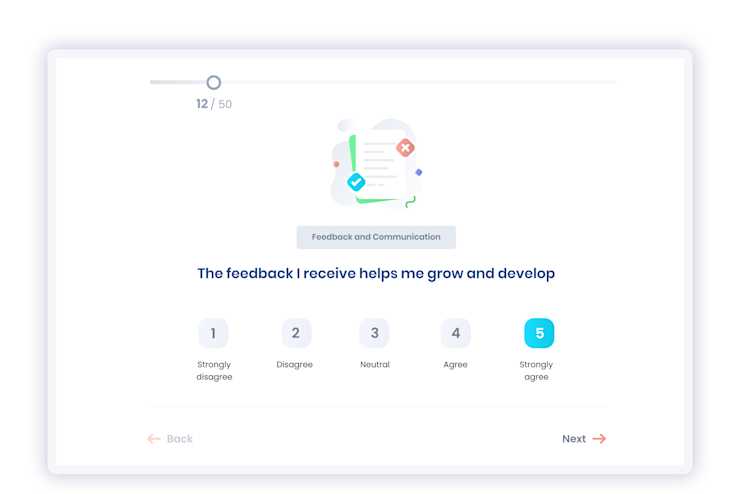There are many employee engagement survey tools out there and many methodologies for measuring the employee experience. Some tools use free text, other a scale of four answers, and some allow the respondent to rate their experience by moving a slider or choosing an icon or symbol.
At Eletive, we use a five-point scale, also known as the Likert Scale. We use this tried and tested approach because it's the methodology that brings the best scientific validity.
What is the Likert Scale?
The Likert five-point scale is a psychometric scale used to measure attitudes and opinions. Psychologist Rensis Likert created this type of scale to quantify response variations in surveys. In a survey using this methodology, respondents are asked to rate something from "strongly disagree" to "strongly agree", where 1 represents "strongly disagree" and 5 represents "strongly agree".

One of the most important benefits is the neutral option in the middle of the scale; number three.
One of the most important benefits of the Likert scale is that the number of options is uneven. This means there is a neutral option in the middle of the scale; number three. If instead, you would present an even number of options, such as four or six, all options will either be weighted against "strongly agree" or "strongly disagree". This means respondents are forced to choose, even if they don't want to. Forcing people to choose when they are, in fact, neutral can skew the validity of the survey results.
Numeric responses are more valuable than visual ones
Some survey tools on the market let employees give their answers by choosing between different emojis or by using a slider to rate their experience. This is often an attempt to create a fun user experience, but it's an approach that comes with some statistical problems.
While numeric responses can easily be analysed and compared to previous results and benchmarks, more visual and subjective responses are difficult to quantify. Let's say that a respondent gives their employee experience a heart, and next time a star – how will you know what each symbol actually means to the respondent? And how can you measure progress?
Asking the right employee survey questions using a five-point scale allows for valid cross-study/survey comparisons. In other words, enables you to compare the employee survey score of one organization/division to that of another.
The Likert Scale, Cronbach's alpha, and the scientific reliability of employee engagement surveys
At Eletive, statistical analysis is continuously performed to ensure that the survey tool meets scientific criteria for good reliability. The reliability is assessed using Cronbach's alpha, a statistical measure of the internal consistency of a test, and is described as a number between 0 and 1. Internal consistency refers to how well different parts of a test measure the same underlying concept.
Analyses show that the internal consistency for the drivers, calculated as Cronbach's alpha, varies from 0,7 to 0,95, with half of the drivers being 0,8 or above. It is essential to keep in mind that the aim of internal consistency is finding the right balance. A too low value, around 0,5 or lower, is not good. A value at 0,6 is considered acceptable. A too high value is not good either. Cronbach's alpha at 1 would not be ideal, as it would mean that all items were identical. In other words, a proper spread is what to aim for.
Besides Cronbach's alpha analysis, bivariate analysis (Pearson correlation) is performed, measuring linear correlation by pairing every single item with all other items. This yields a more in-depth view of the spread within each driver. Analysis shows that, although some drivers have an internal consistency of 0,95, which is considered very high, the spread within these drivers is satisfying. The drivers have proven to be consistent, and the tool in its entirety is to be considered very reliable.

























